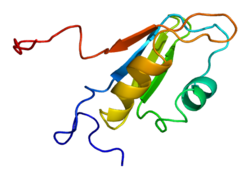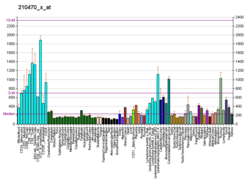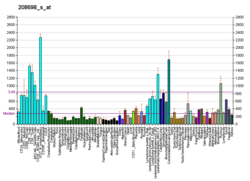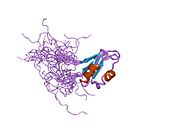This article is about a human protein-coding gene. For other uses, see nono (disambiguation).
Non-POU domain-containing octamer-binding protein (NonO) is a protein that in humans is encoded by the NONO gene.
The NonO protein belongs to the Drosophila behaviour/human splicing (DBHS) family of proteins. Proteins in the DHBS family include mammalian SFPQ (splicing factor, proline- and glutamine-rich; a.k.a. PSF), NONO (Non-POU domain-containing octamer-binding protein; a.k.a. p54nrb) and PSPC1 (paraspeckle component 1; a.k.a. PSP1) and invertebrate NONA (Protein no-on-transient A) and Hrp65.
Interactions
NONO has been shown to interact with SFPQ, SPI1 and Androgen receptor.
Functions
NONO is involved with many nuclear processes and binds to both DNA and RNA.
As with all proteins of the DBHS familprotein is described as a multifunctional nuclear protein. The NONO protein has been shown to be implicated in many biological functions including, pre-mRNA splicing; activation of transcription; termination of transcription; DNA unwinding and pairing and maintaining correct circadian clock function.
NONO has been identified to bind with Rasd1 protein, resulting dimer Rasd1 may act to modulate the function of NONO to down regulate the expression of the CREB genes, NR4A1 and Nr4A2.
NONO binds to SFPQ to form a heterodimer that interacts with the MATR3 protein. The interaction of these three proteins may be part of the process in the nucleus that is responsible for the retention of RNAs that are defective, not yet mature enough to be exported or are designed to be retained in nucleus.
Gene location
NONO protein (Human) is encoded by the NONO gene which is located on the plus strand of the X chromosome.
Role in disease
Melanoma
NONO has been shown to be more strongly expressed in melanoma cell lines and melanoma tissue samples compared to normal human cell lines and normal skin tissue. Studies have found that the knockout of NONO protein from melanoma cell lines results in both reduced proliferation rates of the cancer cells and a significant decrease in the potential migration of the cancer cells.
Breast cancer
Studies into breast cancers have found that the loss or alteration of NONO in conjunction with the loss of the estrogen receptor hERα results in more aggressive breast cancers which show an increase in both tumor size and metastases.
Intellectual disability associated with non-compaction cardiomyopathy
Studies in humans and mice have identified that NONO null mutations likely lead to the development of a clinically recognizable intellectual disability with cognitive and affective deficits. It was later found that these pathogenic variants were also strongly associated with cardiomyopathy with left ventricular noncompaction and sometimes Ebstein's anomaly.
Structure
As with other proteins of the DBHS family, NONO protein functions rarely functions alone and primarily forms homo- and heterodimers with other DBHS proteins to perform its various functions. It is theorised that these dimers may have different functions that are specific to the type of cell that they are found in.
It is speculated that it is the phosphorylation state on NONO that acts to direct the proteins many disparate functions within the nucleus.
Tissue specificity
NONO is found in the nucleus of most mammalian cells and is primarily distributed within the nucleoplasm, it can also be found concentrated within sub-nuclear domains known as paraspeckles.
NONO has also been observed within the brain, localised in the cytoplasm of hippocampal neurons that are associated with RNA transport granules. It is also highly expressed within heart tissue.
Discovery
NONO protein was first discovered in 1993 by researchers at Cold Springs Harbor Laboratory. Due to the protein being originally identified as a RNA-binding protein it was named p54nrb for Nuclear RNA-binding protein, 54 kDa.
References
- ^ GRCh38: Ensembl release 89: ENSG00000147140 – Ensembl, May 2017
- ^ GRCm38: Ensembl release 89: ENSMUSG00000031311 – Ensembl, May 2017
- "Human PubMed Reference:". National Center for Biotechnology Information, U.S. National Library of Medicine.
- "Mouse PubMed Reference:". National Center for Biotechnology Information, U.S. National Library of Medicine.
- Dong B, Horowitz DS, Kobayashi R, Krainer AR (August 1993). "Purification and cDNA cloning of HeLa cell p54nrb, a nuclear protein with two RNA recognition motifs and extensive homology to human splicing factor PSF and Drosophila NONA/BJ6". Nucleic Acids Research. 21 (17): 4085–92. doi:10.1093/nar/21.17.4085. PMC 310009. PMID 8371983.
- Traish AM, Huang YH, Ashba J, Pronovost M, Pavao M, McAneny DB, et al. (August 1997). "Loss of expression of a 55 kDa nuclear protein (nmt55) in estrogen receptor-negative human breast cancer". Diagnostic Molecular Pathology. 6 (4): 209–21. doi:10.1097/00019606-199708000-00005. PMID 9360842. S2CID 1278025.
- "Entrez Gene: NONO Non-POU domain containing, octamer-binding".
- ^ Dong B, Horowitz DS, Kobayashi R, Krainer AR (August 1993). "Purification and cDNA cloning of HeLa cell p54nrb, a nuclear protein with two RNA recognition motifs and extensive homology to human splicing factor PSF and Drosophila NONA/BJ6". Nucleic Acids Research. 21 (17): 4085–92. doi:10.1093/nar/21.17.4085. PMC 310009. PMID 8371983.
- Passon DM, Lee M, Rackham O, Stanley WA, Sadowska A, Filipovska A, et al. (March 2012). "Structure of the heterodimer of human NONO and paraspeckle protein component 1 and analysis of its role in subnuclear body formation". Proceedings of the National Academy of Sciences of the United States of America. 109 (13): 4846–50. Bibcode:2012PNAS..109.4846P. doi:10.1073/pnas.1120792109. PMC 3324020. PMID 22416126.
- Peng R, Dye BT, Pérez I, Barnard DC, Thompson AB, Patton JG (October 2002). "PSF and p54nrb bind a conserved stem in U5 snRNA". RNA. 8 (10): 1334–47. doi:10.1017/S1355838202022070. PMC 1370341. PMID 12403470.
- Hallier M, Tavitian A, Moreau-Gachelin F (May 1996). "The transcription factor Spi-1/PU.1 binds RNA and interferes with the RNA-binding protein p54nrb". The Journal of Biological Chemistry. 271 (19): 11177–81. doi:10.1074/jbc.271.19.11177. PMID 8626664.
- Ishitani K, Yoshida T, Kitagawa H, Ohta H, Nozawa S, Kato S (July 2003). "p54nrb acts as a transcriptional coactivator for activation function 1 of the human androgen receptor". Biochemical and Biophysical Research Communications. 306 (3): 660–5. doi:10.1016/S0006-291X(03)01021-0. PMID 12810069.
- ^ Shav-Tal Y, Zipori D (November 2002). "PSF and p54nrb/NonO – multi-functional nuclear proteins". FEBS Lett. 531 (2): 109–14. doi:10.1016/S0014-5793(02)03447-6. PMID 12417296.
- Duvignaud JB, Bédard M, Nagata T, Muto Y, Yokoyama S, Gagné SM, et al. (May 2016). "Structure, Dynamics, and Interaction of p54(nrb)/NonO RRM1 with 5' Splice Site RNA Sequence". Biochemistry. 55 (18): 2553–66. doi:10.1021/acs.biochem.5b01240. PMID 27064654.
- Basu A, Dong B, Krainer AR, Howe CC (February 1997). "The intracisternal A-particle proximal enhancer-binding protein activates transcription and is identical to the RNA- and DNA-binding protein p54nrb/NonO". Molecular and Cellular Biology. 17 (2): 677–86. doi:10.1128/mcb.17.2.677. PMC 231793. PMID 9001221.
- Danckwardt S, Kaufmann I, Gentzel M, Foerstner KU, Gantzert AS, Gehring NH, et al. (June 2007). "Splicing factors stimulate polyadenylation via USEs at non-canonical 3' end formation signals". The EMBO Journal. 26 (11): 2658–69. doi:10.1038/sj.emboj.7601699. PMC 1888663. PMID 17464285.
- Hallier M, Lerga A, Barnache S, Tavitian A, Moreau-Gachelin F (February 1998). "The transcription factor Spi-1/PU.1 interacts with the potential splicing factor TLS". The Journal of Biological Chemistry. 273 (9): 4838–42. doi:10.1074/jbc.273.9.4838. PMID 9478924.
- Kameoka S, Duque P, Konarska MM (April 2004). "p54(nrb) associates with the 5' splice site within large transcription/splicing complexes". The EMBO Journal. 23 (8): 1782–91. doi:10.1038/sj.emboj.7600187. PMC 394241. PMID 15057275.
- Kowalska E, Ripperger JA, Hoegger DC, Bruegger P, Buch T, Birchler T, et al. (January 2013). "NONO couples the circadian clock to the cell cycle". Proceedings of the National Academy of Sciences of the United States of America. 110 (5): 1592–9. doi:10.1073/pnas.1213317110. PMC 3562797. PMID 23267082.
- Ong SA, Tan JJ, Tew WL, Chen KS (2011-01-01). "Rasd1 modulates the coactivator function of NonO in the cyclic AMP pathway". PLOS ONE. 6 (9): e24401. Bibcode:2011PLoSO...624401O. doi:10.1371/journal.pone.0024401. PMC 3168489. PMID 21915321.
- ^ Zhang Z, Carmichael GG (August 2001). "The fate of dsRNA in the nucleus: a p54(nrb)-containing complex mediates the nuclear retention of promiscuously A-to-I edited RNAs". Cell. 106 (4): 465–75. doi:10.1016/S0092-8674(01)00466-4. PMID 11525732.
- "NONO - Non-POU domain-containing octamer-binding protein - Homo sapiens (Human) - NONO gene & protein". www.uniprot.org. Retrieved 2016-10-14.
- ^ Schiffner S, Zimara N, Schmid R, Bosserhoff AK (August 2011). "p54nrb is a new regulator of progression of malignant melanoma". Carcinogenesis. 32 (8): 1176–82. doi:10.1093/carcin/bgr103. PMID 21642354.
- Pavao M, Huang YH, Hafer LJ, Moreland RB, Traish AM (2001-01-01). "Immunodetection of nmt55/p54nrb isoforms in human breast cancer". BMC Cancer. 1: 15. doi:10.1186/1471-2407-1-15. PMC 59838. PMID 11710964.
- Mircsof D, Langouët M, Rio M, Moutton S, Siquier-Pernet K, Bole-Feysot C, et al. (December 2015). "Mutations in NONO lead to syndromic intellectual disability and inhibitory synaptic defects". Nature Neuroscience. 18 (12): 1731–6. doi:10.1038/nn.4169. PMC 5392243. PMID 26571461.
- Reinstein E, Tzur S, Cohen R, Bormans C, Behar DM (November 2016). "Intellectual disability and non-compaction cardiomyopathy with a de novo NONO mutation identified by exome sequencing". European Journal of Human Genetics. 24 (11): 1635–1638. doi:10.1038/ejhg.2016.72. PMC 5110068. PMID 27329731.
- ^ Scott DA, Hernandez-Garcia A, Azamian MS, Jordan VK, Kim BJ, Starkovich M, et al. (January 2017). "Congenital heart defects and left ventricular non-compaction in males with loss-of-function variants in NONO". Journal of Medical Genetics. 54 (1): 47–53. doi:10.1136/jmedgenet-2016-104039. PMID 27550220. S2CID 206998226.
- Fox AH, Bond CS, Lamond AI (November 2005). "P54nrb forms a heterodimer with PSP1 that localizes to paraspeckles in an RNA-dependent manner". Molecular Biology of the Cell. 16 (11): 5304–15. doi:10.1091/mbc.E05-06-0587. PMC 1266428. PMID 16148043.
- Knott GJ, Bond CS, Fox AH (May 2016). "The DBHS proteins SFPQ, NONO and PSPC1: a multipurpose molecular scaffold". Nucleic Acids Research. 44 (9): 3989–4004. doi:10.1093/nar/gkw271. PMC 4872119. PMID 27084935.
- Fox AH, Lamond AI (July 2010). "Paraspeckles". Cold Spring Harbor Perspectives in Biology. 2 (7): a000687. doi:10.1101/cshperspect.a000687. PMC 2890200. PMID 20573717.
- Kanai Y, Dohmae N, Hirokawa N (August 2004). "Kinesin transports RNA: isolation and characterization of an RNA-transporting granule". Neuron. 43 (4): 513–25. doi:10.1016/j.neuron.2004.07.022. PMID 15312650.
Further reading
- Shav-Tal Y, Zipori D (November 2002). "PSF and p54(nrb)/NonO--multi-functional nuclear proteins". FEBS Letters. 531 (2): 109–14. doi:10.1016/S0014-5793(02)03447-6. PMID 12417296.
- Zhang WW, Zhang LX, Busch RK, Farrés J, Busch H (February 1993). "Purification and characterization of a DNA-binding heterodimer of 52 and 100 kDa from HeLa cells". The Biochemical Journal. 290 (Pt 1): 267–72. doi:10.1042/bj2900267. PMC 1132410. PMID 8439294.
- Hallier M, Tavitian A, Moreau-Gachelin F (May 1996). "The transcription factor Spi-1/PU.1 binds RNA and interferes with the RNA-binding protein p54nrb". The Journal of Biological Chemistry. 271 (19): 11177–81. doi:10.1074/jbc.271.19.11177. PMID 8626664.
- Peters U, Haberhausen G, Kostrzewa M, Nolte D, Müller U (October 1997). "AFX1 and p54nrb: fine mapping, genomic structure, and exclusion as candidate genes of X-linked dystonia parkinsonism". Human Genetics. 100 (5–6): 569–72. doi:10.1007/s004390050553. PMID 9341872. S2CID 35332593.
- Clark J, Lu YJ, Sidhar SK, Parker C, Gill S, Smedley D, et al. (October 1997). "Fusion of splicing factor genes PSF and NonO (p54nrb) to the TFE3 gene in papillary renal cell carcinoma". Oncogene. 15 (18): 2233–9. doi:10.1038/sj.onc.1201394. PMID 9393982.
- Straub T, Grue P, Uhse A, Lisby M, Knudsen BR, Tange TO, et al. (October 1998). "The RNA-splicing factor PSF/p54 controls DNA-topoisomerase I activity by a direct interaction". The Journal of Biological Chemistry. 273 (41): 26261–4. doi:10.1074/jbc.273.41.26261. PMID 9756848.
- Karhumaa P, Parkkila S, Waheed A, Parkkila AK, Kaunisto K, Tucker PW, et al. (May 2000). "Nuclear NonO/p54(nrb) protein is a nonclassical carbonic anhydrase". The Journal of Biological Chemistry. 275 (21): 16044–9. doi:10.1074/jbc.275.21.16044. PMID 10821857.
- Straub T, Knudsen BR, Boege F (June 2000). "PSF/p54(nrb) stimulates "jumping" of DNA topoisomerase I between separate DNA helices". Biochemistry. 39 (25): 7552–8. doi:10.1021/bi992898e. PMID 10858305.
- Mathur M, Tucker PW, Samuels HH (April 2001). "PSF is a novel corepressor that mediates its effect through Sin3A and the DNA binding domain of nuclear hormone receptors". Molecular and Cellular Biology. 21 (7): 2298–311. doi:10.1128/MCB.21.7.2298-2311.2001. PMC 86864. PMID 11259580.
- Zhang Z, Carmichael GG (August 2001). "The fate of dsRNA in the nucleus: a p54(nrb)-containing complex mediates the nuclear retention of promiscuously A-to-I edited RNAs". Cell. 106 (4): 465–75. doi:10.1016/S0092-8674(01)00466-4. PMID 11525732.
- Pavao M, Huang YH, Hafer LJ, Moreland RB, Traish AM (2001). "Immunodetection of nmt55/p54nrb isoforms in human breast cancer". BMC Cancer. 1: 15. doi:10.1186/1471-2407-1-15. PMC 59838. PMID 11710964.
- Andersen JS, Lyon CE, Fox AH, Leung AK, Lam YW, Steen H, et al. (January 2002). "Directed proteomic analysis of the human nucleolus". Current Biology. 12 (1): 1–11. Bibcode:2002CBio...12....1A. doi:10.1016/S0960-9822(01)00650-9. PMID 11790298.
- Sewer MB, Nguyen VQ, Huang CJ, Tucker PW, Kagawa N, Waterman MR (April 2002). "Transcriptional activation of human CYP17 in H295R adrenocortical cells depends on complex formation among p54(nrb)/NonO, protein-associated splicing factor, and SF-1, a complex that also participates in repression of transcription". Endocrinology. 143 (4): 1280–90. doi:10.1210/endo.143.4.8748. PMID 11897684.
- Ohta S, Shiomi Y, Sugimoto K, Obuse C, Tsurimoto T (October 2002). "A proteomics approach to identify proliferating cell nuclear antigen (PCNA)-binding proteins in human cell lysates. Identification of the human CHL12/RFCs2-5 complex as a novel PCNA-binding protein". The Journal of Biological Chemistry. 277 (43): 40362–7. doi:10.1074/jbc.M206194200. PMID 12171929.
- Emili A, Shales M, McCracken S, Xie W, Tucker PW, Kobayashi R, et al. (September 2002). "Splicing and transcription-associated proteins PSF and p54nrb/nonO bind to the RNA polymerase II CTD". RNA. 8 (9): 1102–11. doi:10.1017/S1355838202025037. PMC 1370324. PMID 12358429.
- Peng R, Dye BT, Pérez I, Barnard DC, Thompson AB, Patton JG (October 2002). "PSF and p54nrb bind a conserved stem in U5 snRNA". RNA. 8 (10): 1334–47. doi:10.1017/S1355838202022070. PMC 1370341. PMID 12403470.
| PDB gallery | |
|---|---|







